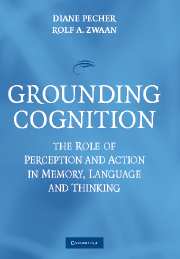Book contents
- Frontmatter
- Contents
- List of Contributors
- 1 Introduction to Grounding Cognition: The Role of Perception and Action in Memory, Language, and Thinking
- 2 Object Concepts and Action
- 3 Constraints on Spatial Language Comprehension: Function and Geometry
- 4 Embodiment in Metaphorical Imagination
- 5 Passionate Thoughts: The Emotional Embodiment of Moral Concepts
- 6 Grounding Language in Bodily States: The Case for Emotion
- 7 Situating Abstract Concepts
- 8 Dynamicity, Fictivity, and Scanning: The Imaginative Basis of Logic and Linguistic Meaning
- 9 The Emergence of Grammar from Perspective
- 10 Embodied Sentence Comprehension
- 11 On the Perceptual-Motor and Image-Schematic Infrastructure of Language
- 12 Connecting Concepts to Each Other and the World
- Author Index
- Subject Index
- References
2 - Object Concepts and Action
Published online by Cambridge University Press: 22 July 2009
- Frontmatter
- Contents
- List of Contributors
- 1 Introduction to Grounding Cognition: The Role of Perception and Action in Memory, Language, and Thinking
- 2 Object Concepts and Action
- 3 Constraints on Spatial Language Comprehension: Function and Geometry
- 4 Embodiment in Metaphorical Imagination
- 5 Passionate Thoughts: The Emotional Embodiment of Moral Concepts
- 6 Grounding Language in Bodily States: The Case for Emotion
- 7 Situating Abstract Concepts
- 8 Dynamicity, Fictivity, and Scanning: The Imaginative Basis of Logic and Linguistic Meaning
- 9 The Emergence of Grammar from Perspective
- 10 Embodied Sentence Comprehension
- 11 On the Perceptual-Motor and Image-Schematic Infrastructure of Language
- 12 Connecting Concepts to Each Other and the World
- Author Index
- Subject Index
- References
Summary
Successful interaction with objects in the environment is the precondition for our survival and for the success of our attempts to improve life by using artifacts and technologies to transform our environment. Our ability to interact appropriately with objects depends on the capacity, fundamental for human beings, for categorizing objects and storing information about them, thus forming concepts, and on the capacity to associate concepts with names. Concepts serve as a kind of “mental glue” that “ties our past experiences to our present interactions with the world” (Murphy, 2002). These concepts are the cognitive and mental aspects of categories (Barsalou, Simmons, Barbey, & Wilson, 2003).
The generally accepted view sees concepts as being made of propositional symbols related arbitrarily to their referents. This implies that there exists a process by which sensorimotor experience is translated into amodal symbols. By proposing that concepts are, rather, grounded in sensorimotor activity, many authors have shown the limitations of this view (Barsalou, 1999; Harnad, 1990; Thelen & Smith, 1994). According to Barsalou (1999), concepts are perceptual symbols – i.e., recordings of the neural activation that arises during perception – arranged as distributed systems or “simulators.” Once we have a simulator it is possible to activate simulations, which consist in the reenactment of a part of the content of the simulator.
This view presupposes a close relationship among perception, action, and cognition.
Information
- Type
- Chapter
- Information
- Grounding CognitionThe Role of Perception and Action in Memory, Language, and Thinking, pp. 8 - 34Publisher: Cambridge University PressPrint publication year: 2005
References
Accessibility standard: Unknown
Why this information is here
This section outlines the accessibility features of this content - including support for screen readers, full keyboard navigation and high-contrast display options. This may not be relevant for you.Accessibility Information
- 36
- Cited by
